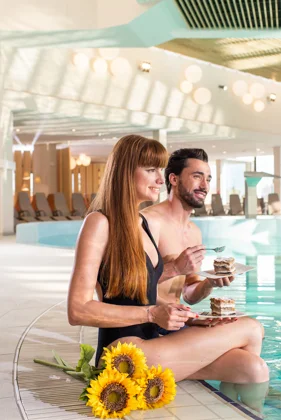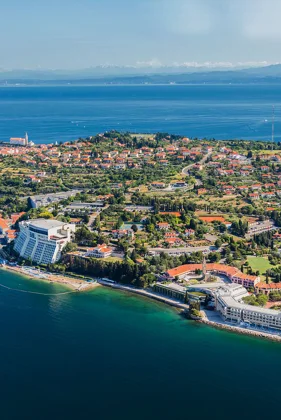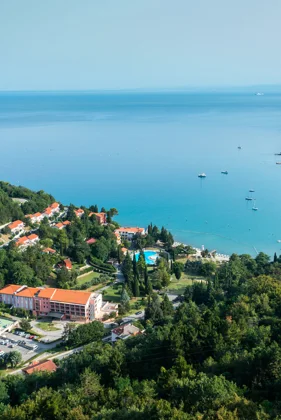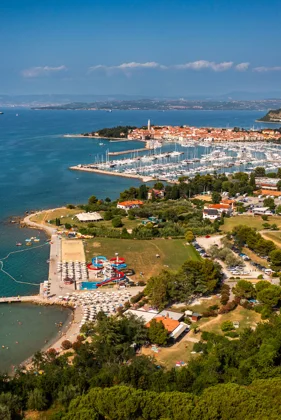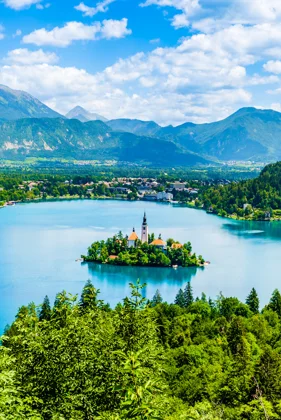So what is worth seeing in Piran?
1. Tartini square
At the end of the 13th century the square became the main square of the town and in the second half of the 19thcentury it got the »look« it has now. The port was filled in and the spacious square was built, with all the important buildings of Piran - such as the town hall and the praetorian palace - around it. The square is circled by numerous bourgeois buildings, which unfortunately have lost their original form. The only exception is the wonderful gothic building known as the Venetian house.
The square is named after the famous and internationally acclaimed local,the violinist and composer Tartini, who took the name of his hometown into the world.
2. Tartini’s statue
In 1892, in honour of the 200th anniversary of Tartini’s birth, the people of Piran wanted to build a statue in his honour. Work was delayed and the statue was made only in 1896. The life-size statue is made of bronze and was created by the sculptor Antonio dal Zotto. The statue is located on Tartini square and nicely connects the square with the church of St. George.
3. Tartini’s house
The house where Tartini was born is one of the oldest in Piran. In the town’s documents we can see that it was mentioned already in 1384 as the gothic building named Casa Pizagrua. It was later renovated in neoclassical style and has seen the latest renovation work between 1985 and 1991.
Today it is the seat of the Italian Community, which also owns the house. It is a venue for numerous cultural events, exhibitions and art workshops. Of course the house has a memorial room with Tartini’s personal objects. Here you can see his death mask, his violin, a copperplate engraving of Tartini’s dreams and Tartini’s oil portrait. His letter to the famous violinist Maddalena Lombardini, who was his student, is a very interesting exhibit.
4. The town wall
The town’s centre was most likely protected by a wall already in the 7th century. From then the wall expanded towards the southeast, embracing new town quarters as they were built. Most of the preserved wall dates back to the 15th and 16th century, it was part of the town’s medieval structure. The remains of the wall on the hillside of Mogronhave a special historical value.
5. Minorite monastery Piran
The monastery of St. Francis was probably founded already in 1301 when the construction of the church began. At the beginning the monastery was built in gothic style and it only had the ground floor, but later it was renovated and expanded. In the 17thand 18th century approximately 11 priests and 10 monks lived in the monastery. They helped in various schools and had their own school for future monks as well as a music department. It is believed that Tartini himself acquired his basic musical education here.
6. The aquarium
The aquarium is located next to the inner port, at Kidričevo nabrežje 4. It was founded already in 1964, but it was operative a few years later. It has three tanks with 100, 300 and 2000 liters. In the aquarium you can see 200 different species of marine animals, among which the octopus, the common sea bream, the colourful wrasses, the dentex, the stone loach, the gobies, the big grouper and many more. There are of course also many varieties of algae.
7. The maritime museum of Piran
It was founded in 1954 and it is a museum of the maritime history of Slovenia. It was named after the hero Sergej Mašera a few years later in 1967. In the museum you will discover interesting facts about Slovene maritime history and there is also an archaeological collection about maritime trade routes and commerce. You will also find a collection of settlement artefacts, which were recovered from the sea and from dry land. Moreover, there is a special ethnological collection, which illustrates the process of salt harvesting.
8. The saltpans of Piran
The saltpans were built in 804 and they had three locations: Fazan saltpans in Lucija, smaller saltpans in Strunjan and the largest in Sečovlje. Through the cultural heritage of the saltpans of Piran we can get to know the life and the work of the saltpan workers. Of the once numerous saltpans in the Gulf of Trieste only the ones in Sečovlje and Strunjan still exist today, so they are extremely valuable.
9. St. George’s church
The church dates to the 17th century and has a richly decorated baroque interior with an interesting statue of St. George fighting a dragon. Behind the altar hides the biggest treasure of Piran, a crucifix from the 14th century. Definitely worth the visit!
10. 1st of May square
The 1st of May square is the center of old Punta and was once called Old square. Interestingly, all the main town streets converge here. Until the 13th century the Old square used to be the administrative centre of town, the old town hall was also located here. On the square you will find a rainwater cistern, which was built after the great drought in 1775. The cistern is adorned by two statues, one of which is carrying a fish and the other a vase. Nowadays the square is a favourite meeting point for children and a venue for musical, dance and theatre events.
11. Town hall
When the Venetians arrived in Piran in the 13thcentury, they built the town hall outside the town’s wall. It was built in a distinctive Romanic-gothic style, its façade was rich with coats of arms and various inscription plates. The building was torn down in 1877 and with it also the connecting passage that linked the town hall to the ancient loggia.
The new town hall was built two years later. It is embellished by a stone lion holding an open book as a tribute to the Venetian republic and the old town hall. An interesting fact about these lion statues: an open book stands for times of peace, whereas a closed book for times of war. In the atrium of the town hall you can see inscription plates with coats of arms from the old town hall. You can also see a polygonal stone with quantity measures.
12. Loggia
The old loggia used to stand where you can now find the Coastal galleries. It was connected with the town hall and with St. Jacob’s church. Reading about its history we discover that inside it there used to be a cattaveri office: the cattaveri were protectors of the town’s property. The loggia was also a meeting place for the town’s elite.
13. The Venetian house
The charming building can be found where IX. Korpus street meets Tartini square. Without any doubt it is the most beautiful example of venetian-gothic architecture in Piran. It was built in the 15th century and it is the oldest building on Tartini square. It has wonderfully shaped architectural elements and rich stone decoration. The gothic balcony really stands out.
On the façade there’s a stone plate with a lion, underneath it there is the inscription “Lassa pur dir” (meaning “let them talk”). According to legend, a rich Venetian merchant fell in love with a beautiful girl from Piran and to prove his love he built her a house – the Venetian house. The inhabitants of Piran were jealous and gossiped about the couple, thus the lovebirds decided to retort with the above-mentioned inscription.
14. The praetorian palace
Where you can now see the praetorian palace, in the 14thcentury there used to be a warehouse for grain and flour. The palace was built by Giuseppe Moso and Enrico Nordio. The building has been renovated many times, as told also by the inscription plates on the building’s façade.

